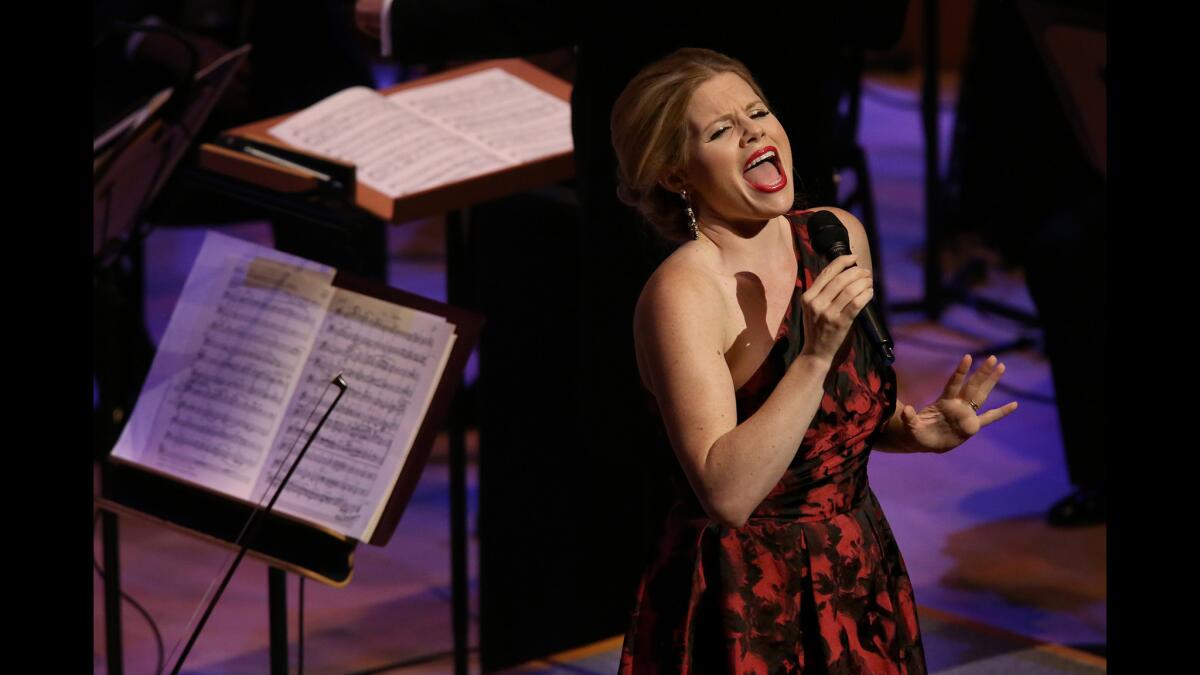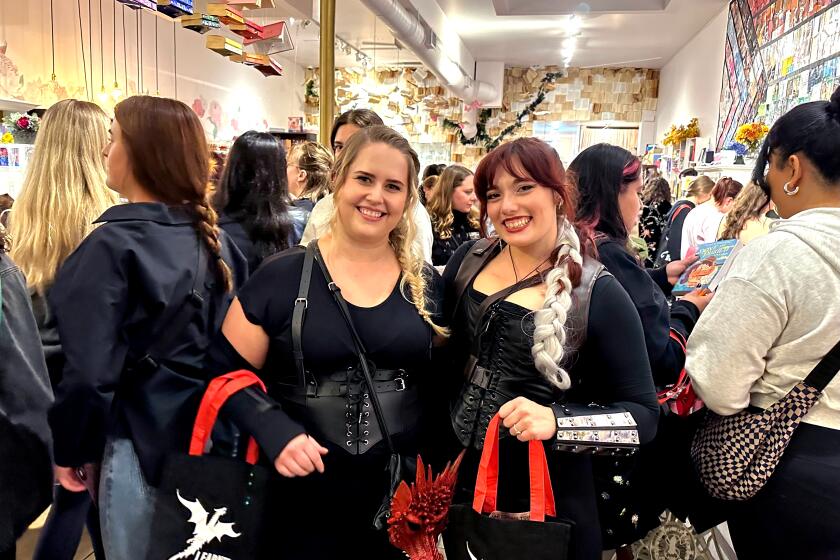Hear Laura, Lillias, Megan and Betty sing in their living rooms. Well, almost
- Share via
Cabaret was once considered somewhat seedy. In Germany between the world wars, it was, in the words of Betty Buckley, “a gathering place for fantasy and escape, with a sense of the subversive.”
Today, it’s still a place to escape the world for a few hours, but otherwise it has little in common with the aesthetic of the musical “Cabaret.” It’s more likely to take you to a place of domestic bliss — or at least a facsimile thereof.
“Ultimately, we want to make it feel like you’ve stumbled into our living room,” said Megan Hilty, who will perform this week at Segerstrom Center for the Arts with a band that includes her husband, Brian Gallagher.
Laura Benanti, who brings her act to California twice in early 2020 — Walnut Creek in January and Costa Mesa in April — echoed Hilty’s sentiment: “I want people to feel like they’re in my living room, and I’m singing them songs and telling them stories.”
So put down the knitting and find yourself a spot on the sofa.
For the performers, the real question is how do you make a 300-seat theater feel like home? Five world-class cabaret singers produced a consensus answer: authenticity.
“I don’t see the point of doing cabaret if you’re not willing to make yourself vulnerable and share a part of yourself,” said Cheyenne Jackson, who will costar with Hilty at the Wallis Annenberg Center for the Arts in February.
Veteran vocalist Lillias White agreed. “If I’m moved by a lyric or a melody, the audience will be as well.”
That said, a personal connection is the first of many considerations when choosing songs for a cabaret act. Working closely with their music directors, some singers constantly tweak their set lists, while others start from scratch on a regular basis.
“It takes months for me to put a show together,” said Buckley, who has been singing cabaret since 1982 and puts together a new show every year. “I’m a kind of portrait painter. I think of each as my new gallery show.
“I’m not really into nostalgia,” she added. “I’m not interested in constantly presenting songs that I’m particularly known for. What I enjoy is seeking out new material — or at least new to me. Songs that resonate in the time period in which we’re living.”
Hilty said she’s changing constantly, so her show changes constantly too. She agreed that new material is essential, arguing that “otherwise, it’s like, ‘I can see all this on YouTube.’”
Benanti sees cabaret as a way to express her eclectic taste in music.
“I think people know they’re going to hear musical theater songs, but I hope they’re pleasantly surprised when they also hear Joni Mitchell and Harry Chapin or Tori Amos,” she said.
Benanti chats with the audience between every song; she calls her approach “very conversational.” In contrast, Buckley and White have cut back on their banter over the years.
“I’m always looking for the most succinct way to talk to an audience, so I don’t waste their time with my long-windedness,” Buckley said with a laugh. “That is always a challenge for me.”
“I actually have several different stories to introduce most of my songs,” Hilty said. “I’ll choose one over another depending on how I’m feeling in the moment and how it connects to what we just said. If I feel I’m losing an audience, I’ll cut the banter altogether.
“I want everybody to be on kind of an energy ride. There are certain spots in the set that need a certain type of song. With attention spans being what they are, I feel ballads need to be earned. If you do too many, people won’t listen to the lyrics. They’ll just tune out. I want people to really hear them. So I’m very selective about what ballads I do, where they’re placed, and when I think the audience is ready to hear them.”

Buckley, who is similarly careful about sequencing, sees her mission in spiritual terms.
“It’s about bringing people into that remembrance of their spirit, their soul,” she said. “To the degree I’m capable of doing it, that’s my mission: to remind people we’re all in this together, and to move the stress of the moment off their hearts. You pick stuff that will allow people to have some kind of catharsis, whether it’s a release of sadness or joy.”
Much of that “stress of the moment” can be traced to our nation’s intense polarization, but all the performers tread lightly when it comes to making political statements. Both Buckley and Jackson sing the song “Hope,” which Jason Robert Brown (“The Last Five Years,” “Parade”) wrote just after the 2016 election in a poignant attempt not to give in to despair.
For her part, Hilty performs “a couple of songs that aren’t overtly political but you can hear them that way, such as Don Henley’s ‘The Heart of the Matter.’ Although they were written 30 years ago, those lyrics resonate today in a subtle but powerful way.”
White, who admitted that television news sometimes brings her to tears, went in a different direction: Her current show “Get Happy” is designed to lift spirits during depressing times. In a similar spirit, Benanti places her emphasis on comedy and warmth.
“Cabaret can be thought of as stuffy or archaic, but it doesn’t have to be,” she argued. “There are opportunities for humor and heart, improvisation and connection. I feel the highest compliment I have been given is when people say to me, ‘I want to be your best friend.’”
Cabaret calendar
Megan Hilty: 7:30 p.m. Thursday-Saturday, Segerstrom Center for the Arts, Costa Mesa. (714) 556-2787 or www.scfta.org
Lillias White: 7:30 p.m. Jan. 23-25, Segerstrom Center, Costa Mesa
Megan Hilty and Cheyenne Jackson: 7:30 p.m. Jan. 25, Wallis Annenberg Center for the Performing Arts, Beverly Hills. (310) 746-4000 or thewallis.org.
Laura Benanti: 7:30 p.m. April 23-25, Segerstrom Center, Costa Mesa
You always can find our latest stage news and reviews at latimes.com/theater.
More to Read
The biggest entertainment stories
Get our big stories about Hollywood, film, television, music, arts, culture and more right in your inbox as soon as they publish.
You may occasionally receive promotional content from the Los Angeles Times.










